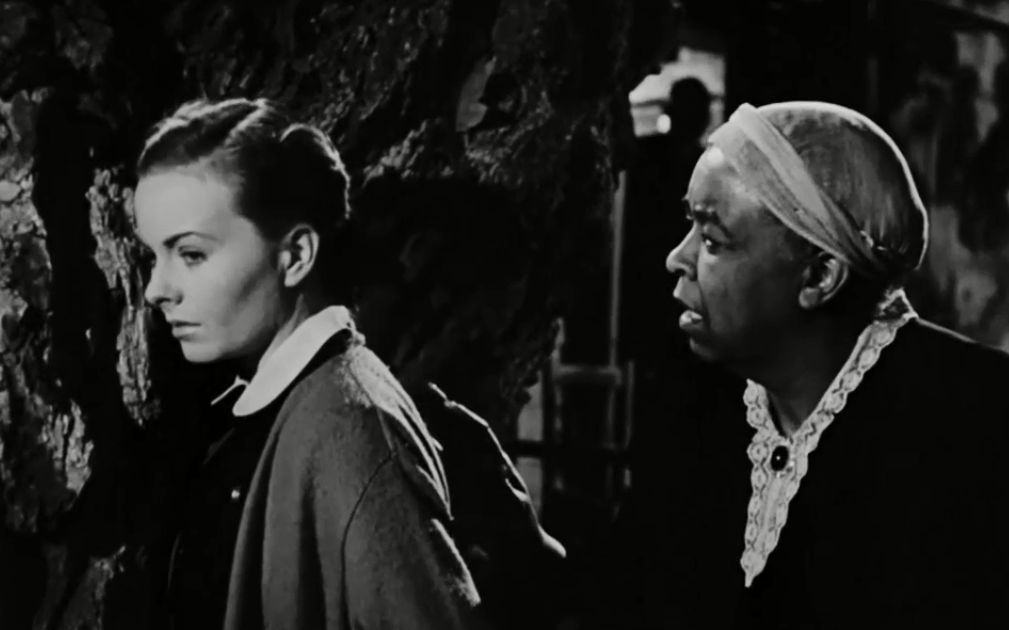 |
| Starring Jeanne Crain and Ethel Waters, the 1949 race drama “Pinky” sparked controversy. |
 |
| In “Pinky,” Jeanne Crain portrays a character who passes for white in the North but faces stark racial realities when she returns home. |
Recently, I watched the 1949 film Pinky for the first time and was struck by how relevant its racial themes remain nearly 75 years later. This film was a follow-up to the significant Gentleman’s Agreement, made by 20th Century Fox and directed by Elia Kazan.
For years, I hesitated to watch this movie, as the idea of Jeanne Crain portraying a character who passes for white seemed far-fetched. To me, Crain always epitomized the classic “white bread” actress. Rumor had it that her contemporaries, like Linda Darnell, would have been a more believable choice for the role of Pinky, given her striking features. Darnell’s talent for portraying tough characters might have brought depth to the role. However, 20th Century Fox head Darryl F. Zanuck chose Crain, despite Kazan’s preference for Darnell.
 |
| Linda Darnell, a potential candidate for the role of “Pinky,” showcased striking features. |
 |
| Dorothy Dandridge, another actress considered for the role of “Pinky.” |
Some have suggested that Lena Horne or Dorothy Dandridge might have been suitable for the role of Pinky. Would either actress have been believable as passing for white to 1949’s audiences? It’s possible, but uncertain. Other factors come into play; for instance, Lena was already over 30 when Pinky was produced, while the character was just starting her nursing career. Conversely, Dandridge had not yet achieved stardom at that time, which might have worked in her favor. However, casting a Black actress in romantic scenes with a white lead would have faced challenges in certain states. Unlike Julie in 1953’s Showboat, Pinky’s ability to pass for white was a central theme. Yet, audiences needed to be convinced that Pinky could indeed blend in, raising questions about how Horne’s involvement might have influenced that perception.
 |
| Lena Horne in ’49, expressing interest in playing “Pinky.” Although she was older than the other candidates, she was a significant star. |
Reflecting on this, Fredi Washington comes to mind, celebrated for her work in the original 1934 version of Imitation of Life, where she portrayed Peola, a character who passes for white. Despite her capability to pass in real life, Washington proudly embraced her mixed heritage, foregoing opportunities in Hollywood as a result.
 |
| Fredi Washington, a mixed-race actress, excelled portraying a character passing for white in the original “Imitation of Life,” produced 15 years prior to “Pinky.” |
I was also impressed by the straightforward approach taken by the film and Jeanne Crain while depicting Pinky’s story. Although filmed on a studio lot, the movie manages to feel genuine. Upon returning from the North as a nursing school graduate, Pinky’s home in the southern black community isn’t depicted as quaint but rather rundown. Crain’s portrayal of Pinky is devoid of glamour; her character dresses modestly and maintains a simple hairstyle and makeup. Her performance is sincere and devoid of any overt pretense. Pinky is often conflicted about returning home, having the option to easily remain in the North where she could pass for white, but the determined nurse chooses not to take the easy route.
 |
| Jeanne Crain’s “Pinky” shows mixed emotions upon meeting Ethel Waters’ Grandma Dicey, reflecting her complex feelings about returning to the South. |
Kazan expressed a desire to shoot the film in the South, emphasizing that the studio lot did not capture the gritty realities of the setting. He was undoubtedly justified in his viewpoint, noting the absence of the region’s authentic heat, dirt, and poverty. However, even decades later, Hollywood exhibited reluctance to film in the South with a Black lead in a racially charged narrative. Kazan’s strategy regarding the film’s location contrasts sharply with his choices for productions that did happen without the limitations that existed at that time.
 |
| Crain’s “Pinky” contemplates the impoverished conditions of her Grandma Dicey’s surroundings, with Miss Em’s mansion looming in the background. |
Kazan stepped in to direct with little notice after John Ford, bringing to the film his unique perspective and compelling storytelling style. However, some may feel he undermined the contributions of the original screenwriters, Dudley Nichols and Phillip Dunne. While credit for guiding Crain’s performance goes to Kazan, some of his comments suggest he viewed it almost as a challenge to elicit quality from an actress he deemed inexperienced, which can seem dismissive. Both Crain and Waters delivered strong performances, making their characters come alive despite the circumstances. At just 24, Crain was close to the character’s age, freshly returning to work shortly after giving birth to a baby. This meant that filming was not particularly easy for her.
 |
| “Pinky” experiences harsh reminders of her racial identity amid a police encounter, reflecting the realities of racial dynamics in her hometown. |
The original novel for Pinky, titled Quality, was penned by Cid Ricketts Sumner, who also authored Tammy out of Time, a precursor to the beloved Tammy series of movies and television. Audiences regarded the film’s seemingly optimistic ending as a compromise, especially since the character of Pinky ultimately converts Miss Em’s mansion into a Black nursing school. Conversely, the original book portrayed a grim outcome in which the local KKK retaliated against Pinky’s success by burning down the house. This thought lingered in my mind while watching the film; realistically, such a fate could have easily transpired. The studio’s desire for a hopeful conclusion is understandable given the film’s serious subject matter. Nevertheless, it is noteworthy that the character of Pinky decides against a marriage proposal that would require her to deny her racial identity—a significant step forward for the narrative.
 |
| In a poignant moment, Ethel Waters as Grandma Dicey conveys a wealth of emotion in “Pinky.” |
Pinky’s supporting cast is outstanding, highlighted by two exceptional Ethels. Ethel Waters brings warmth and depth as Grandma Dicey, providing straightforward insights regarding Pinky’s past and experiences with passing. Although respected in her community, Aunt Dicey often encounters condescension from white individuals. Waters showcases her character’s strength effectively, often communicating volumes through her silence. Ethel Barrymore, embodying her usual grande dame persona, adds an unexpected edge to her portrayal, elevating the unsentimental nature of her character.
 |
| As Pinky cares for Miss Em in her twilight, a strong bond develops despite their earlier conflicts. |
Evelyn Varden gives a strong performance as Melba Wooley, Miss Em’s cousin, embodying traits reminiscent of the ubiquitous Sister Woman from Cat on a Hot Tin Roof! Her character not only exhibits blatant racism but also displays a façade of dishonesty akin to Big Daddy’s declarations in Cat. Those who label Melba as one-dimensional might want to explore contemporary examples of racism, indicating that not much has changed in terms of ignorance over time. Varden would later become known for portraying Monica Breedlove, an iconic character in the 1956 film The Bad Seed.
 |
| Pinky’s strained encounter with Miss Em’s racist cousin Melba, a portrayal by Varden full of nuance. |
It’s essential to recognize that Pinky was produced over seventy years ago—a pioneering narrative in tackling race issues as a central theme rather than merely brushing over them. For viewers in 1949, embracing Pinky as serious cinema marked a significant progression. It stands out in cinematic history, being one of 20th Century Fox’s highest-grossing dramas for that year.
Nearly ten years later, 20th Century Fox would produce Island in the Sun, an interracial drama that, in my view, doesn’t hold a candle to the intensity of Pinky! Here’s my take on Island in the Sun:
https://ricksrealreel.blogspot.com/2020/07/island-in-sun-1957.html
 |
| The film “Pinky” was released with this disclaimer in 1949. |
 |
| As “Pinky,” Jeanne Crain reveals her racial identity to her fiancé in a symbolically charged moment, where the lighting casts a shadow over her. |




